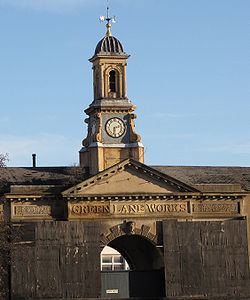 | ||
Spyband diamonds are forever live at green lane works kelham island
The Green Lane Works are a disused industrial facility situated in the City of Sheffield, England. The entrance gate to the works is particularly ornate and has been designated as a Grade II* listed building. Nikolaus Pevsner called the gate “the most spectacular survival of factory architecture in the city”. The works are situated in the suburb of Neepsend within the Kelham Island Quarter of the city and date from 1795 although there were extensive alterations in 1860.
Contents
- Spyband diamonds are forever live at green lane works kelham island
- Spyband theme from the mysteron live at green lane works kelham island 12 september 2014
- History
- Entrance gateway
- Latter history
- References
Spyband theme from the mysteron live at green lane works kelham island 12 september 2014
History
The original Green Lane Works were established in 1795 by the firm of Hoole and Company who were manufacturers of ornamental stove grates and fenders in Bronze and metal. The firm flourished and their products won a first Council medal at The Great Exhibition of 1851 and a Medaille d'honneur at the Exposition Universelle of 1855. This success brought considerable prestige to the firm and its proprietor at the time Henry E. Hoole. In 1859 Hoole was elected Lord Mayor of Sheffield and to celebrate this he had major alterations carried out to the works.
Entrance gateway
The most important part of the 1860 rebuilding was the construction of the decorative entrance arch on Green Lane. It is thought that the sculptor Alfred Stevens designed the gatehouse and may have been responsible for the relief sculptured decoration. Stevens had worked for Hoole and Company between 1850 and 1852 as chief designer on a salary of £20 per annum and had designed much of the firms award winning work for the 1851 exhibition. When he returned to London after two years with Hooles he left behind him many drawings and designs for apprentices to study.
The Gateway is constructed of ashlar, stucco and brick and takes the form of a tripartite triumphal arch with a carving of a female head on the keystone above the main (central) arch. The two outer (pedestrian) arches have relief panels of the Greek gods Hephaestus (left) and Athena (right) above them. The name of the works is carved above the central arch and above this is an apex roof which at one time had a coat of arms on it which is now missing. The gateway is topped off by a cupola with clock and weather vane.
Latter history
The works were considerably damaged in the Great Sheffield Flood of March 1864 with Samuel Harrison in his “A Complete History of the Great Sheffield Flood” saying:
The works continued to make stove grates and fenders until 1930, up until 1948 it produced files as part of the Ibbotson Brothers group. In April 1948 the works were purchased by W.A. Tyzack who produced agricultural tools and parts for farm machinery. In late 2009 the works are disused with its future unknown. The gateway has been partly bordered to protect it from vandalism.
